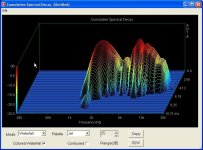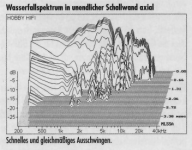After SY did his analysis of the C37 he sent me the remainder of the bottle to try out on speakers. We treated a number of paper cone speakers,
We found that the results varied depending on the paper we treated. Puzzlekoat (PVA) was used as an alternate coating for comparison.
Both C37 & PK mostly did the same sort of thing -- lowered the noise floor of the driver. The theory i had developed some time ago wrt PK is that the binding of the surface fibres is the primary mode of this improvement.
Which worked better depended on the cone, and seemed to be dependent on how easily the C37 went on to the cone material... on some cones (ie CSS FR125) the C37 easily flowed and spread on to the cone almost as if it was trying to spread itself, on some cones (ie Fostex banana paper) it was a real struggle to get the C37 to spread.
The FR125 was dramatically improved with the addition of 2 vanishingly thin coats of C37, the same driver with PK exhibited not quite as much improvement. A practical consideration also gave the edge to the C37. It was far to easy to accidentily get PK into the voice coil gap effectively gluing the voice coil to the phase plug.
The Fostex was another story. Overall the C37 improved the FE127, but attenuated the highs somewhat. PK on the other hand achieved the same result without as much HF attenuation, The C37 did give the Fostex cones a lovely parchment-like colour.
A number of other drivers exibited similar improvement.
A comment on the price of C37 is warranted here, Althou something like $150 per oz (vrs <$10 for 8 oz of PK), in the end the amount used on a speaker cone is very small. Using the FR125 as an example, i would estimate that one could close in on doing 100 drivers with your minimum 1 oz purchase.
All this research now needs to be started over, as EnABL technology completely swamps what either of these 2 do on their own (the conformal )micro-gloss) post-coating accomplishing a similar effect to the C37 or PK), and now it is a matter of whether a pre-coat of either of these benefits the sonics after EnABLing. PK as a pre-coat is beneficial with the Fostex cones, that is as far as i have gotten, PK also has a practical effect on the EnABL process, as it lets the acrilic spots sit on the cone surface instead of seeping into the paper. This 1/ gets maximum bump from the acrylic, 2/ allows for more accurate spoy shape, and 3/ gives a small margin for recovering from a bad spot that an un-pre-treated cone does not.
My gut feeling is that given the similar affects of PK, C37 and the micro-gloss, and the need to use the micro-gloss with the EnABL, that the need for C37 in your driver mod kit is greatly reduced if not made completely unnecessary.
I will continue to experiment thou.
dave
We found that the results varied depending on the paper we treated. Puzzlekoat (PVA) was used as an alternate coating for comparison.
Both C37 & PK mostly did the same sort of thing -- lowered the noise floor of the driver. The theory i had developed some time ago wrt PK is that the binding of the surface fibres is the primary mode of this improvement.
Which worked better depended on the cone, and seemed to be dependent on how easily the C37 went on to the cone material... on some cones (ie CSS FR125) the C37 easily flowed and spread on to the cone almost as if it was trying to spread itself, on some cones (ie Fostex banana paper) it was a real struggle to get the C37 to spread.
The FR125 was dramatically improved with the addition of 2 vanishingly thin coats of C37, the same driver with PK exhibited not quite as much improvement. A practical consideration also gave the edge to the C37. It was far to easy to accidentily get PK into the voice coil gap effectively gluing the voice coil to the phase plug.
The Fostex was another story. Overall the C37 improved the FE127, but attenuated the highs somewhat. PK on the other hand achieved the same result without as much HF attenuation, The C37 did give the Fostex cones a lovely parchment-like colour.
A number of other drivers exibited similar improvement.
A comment on the price of C37 is warranted here, Althou something like $150 per oz (vrs <$10 for 8 oz of PK), in the end the amount used on a speaker cone is very small. Using the FR125 as an example, i would estimate that one could close in on doing 100 drivers with your minimum 1 oz purchase.
All this research now needs to be started over, as EnABL technology completely swamps what either of these 2 do on their own (the conformal )micro-gloss) post-coating accomplishing a similar effect to the C37 or PK), and now it is a matter of whether a pre-coat of either of these benefits the sonics after EnABLing. PK as a pre-coat is beneficial with the Fostex cones, that is as far as i have gotten, PK also has a practical effect on the EnABL process, as it lets the acrilic spots sit on the cone surface instead of seeping into the paper. This 1/ gets maximum bump from the acrylic, 2/ allows for more accurate spoy shape, and 3/ gives a small margin for recovering from a bad spot that an un-pre-treated cone does not.
My gut feeling is that given the similar affects of PK, C37 and the micro-gloss, and the need to use the micro-gloss with the EnABL, that the need for C37 in your driver mod kit is greatly reduced if not made completely unnecessary.
I will continue to experiment thou.
dave
planet10 said:A number of other drivers exibited similar improvement.
Hi Dave,
Did you do more experiments with other drivers, and in particular with the FR8/FR8C?
I see there is a lot of dammar usage for cone treatment. Has anybody ever considered using amber varnish for this? I mention this because amber is the strongest natural resin and fairly tough mechanically, so could possibly be a useful alternative, especially when it is desired to add less mass.
Also some musical instrument makers believe in 'ash' varnishes where wood ash is added. Their belief is that the heavier metallic elements in wood ash assist the varnish in its stiffness and damping characteristics. However, not all wood ash is the same here!
The species of tree, whether the wood, bark or leaves are burned, etc. all have strong effects on the exact composition of heavier elements in the ash such as aluminum, calcium, iron, potassium, magnesium, manganese, sodium, phosphorus, tin and silicon. Even the climate, soil and time of year the tree is harvested and what temperature the wood is burned at play a (less important) part.
Interesting stuff. I would be interested in others' thoughts on this.
Also some musical instrument makers believe in 'ash' varnishes where wood ash is added. Their belief is that the heavier metallic elements in wood ash assist the varnish in its stiffness and damping characteristics. However, not all wood ash is the same here!
The species of tree, whether the wood, bark or leaves are burned, etc. all have strong effects on the exact composition of heavier elements in the ash such as aluminum, calcium, iron, potassium, magnesium, manganese, sodium, phosphorus, tin and silicon. Even the climate, soil and time of year the tree is harvested and what temperature the wood is burned at play a (less important) part.
Interesting stuff. I would be interested in others' thoughts on this.
- Status
- This old topic is closed. If you want to reopen this topic, contact a moderator using the "Report Post" button.
- Home
- Loudspeakers
- Multi-Way
- C37 similar material

